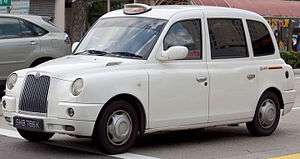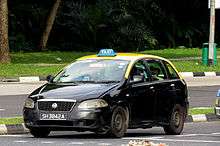Taxicabs of Singapore
_1.7_CRDi_sedan%2C_Comfort_Taxi_(2016-01-03).jpg)
_1.7_diesel_sedan%2C_Silvercab_(2016-01-03)_01.jpg)

Taxicabs are a popular form of public transport in the compact sovereign city-state of Singapore, with fares considered relatively low compared to those in most cities in developed countries. As of September 2016, the total taxi fleet in Singapore is 27,708 taxis, operated by six taxi companies and 128 independent drivers.[1]
Within the country's ethnic Chinese population, taxis are colloquially called 德士 (déshì). Similar to Hong Kong, the name derives from the English term "Taxi".
Taxis may be flagged down at any time of the day along any public road outside of the Singapore Central Business District (CBD). Issues of high traffic and demand in certain locations and areas, particularly in the downtown area and other major buildings and establishments around the island, require the building of taxi stands. As taxis may conversely be harder to obtain in less densely populated areas, as well as to meet the needs of time-sensitive users, taxis may be booked via telephone or through the internet for a fee, which is then transmitted to individual taxis via a Global Positioning System (GPS) or digital voice dispatch.
Stringent requirements ensure that all taxis are fitted with meters and are air-conditioned and serviceable. Drivers who fail to utilise their meters may be fined up to S$500, an enforced rule which brings fare disputes down to a minimum. About 90% of taxis have inbuilt AM broadcasting communications.
Operations
Taxis are predominantly operated by large companies, which require a Taxi Operator Licence (TOL) from the Land Transport Authority (LTA). Holders of the TOL are required to comply with LTA's Quality of Service (QoS) standards, codes of practice and audit directions, failure of which the LTA may revoke the licence.
As of September 2016, there are six taxi companies holding the TOL. The other two are considered GrabTaxi or Uber:[1]
| Holding company | Taxi company | TOL started in | Fleet | Brand | Dominant colour | Link |
|---|---|---|---|---|---|---|
| ComfortDelGro Corporation | Comfort Transportation CityCab | 1970 1995 | 12,591 4,281 | Comfort CityCab | Blue Yellow | |
| SMRT Corporation | SMRT Taxis | 2003 (June) | 3,434 | SMRT | Brown | |
| Trans-Cab Services | Trans-Cab Services | 2003 (August) | 4,593 | TRANS-cab | Red | |
| Premier Corporation | Premier Taxis | 2003 (October) | 1,938 | Silvercab | Silver | |
| Prime Leasing | Prime Car Rental & Taxi Services | 2007 | 743 | PRIME TAXI | Copper | |
| Total | 27,580 (excluding 128 "Yellow-Top" taxis operated by individual driver-owners[2] and 100 HDT electric taxis[3]) | |||||
All taxi drivers in Singapore are required to hold a valid Taxi Driver's Vocational Licence (TDVL) issued by the Land Transport Authority, after having met basic prerequisites and successfully completed a training course in the Singapore Taxi Academy and passing a theory test. Holders of the licence may then approach any of the taxi companies to hire a taxi on a daily rental basis, the rental rate and associated benefits of which vary among the various companies.
As of September 2016, there were a total of 100,513 TDVL holders in Singapore.[1]
Fares
Fares on Singapore's taxis are considered relatively affordable and even "cheap",[4] and are thus a popular form of public transportation in Singapore, particularly for the upper-middle income groups. Taxi fares were regulated by the Public Transport Council until September 1998 to allow operators full freedom in setting their own fares in a bid to introduce greater competition in the market.
In July 2006, ComfortDelGro raised fares for all three operators under its umbrella, and SMRT Taxis and TransCab followed suit.[5] Premier Taxis adjusted its fares differently by only increasing some fare components, while SmartCab chose not to raise its fares at all, resulting in the most marked price differentiation between the companies since deregulation in 1998. One month later, it was reported that these fare adjustments had resulted in a drop of up to 20% in earnings for taxi drivers.[6]
All taxi fares are metered, and it is an offence for taxi drivers to disable, tamper with, or fail to use their metering devices. Drivers found guilty may be fined up to S$500.
On 10 December 2007, ComfortDelGro announced another revision in fares with increases ranging from 10 to 49%, due for implementation by 17 December 2007. It called on other taxi companies to follow its fare structure "as soon as possible".[7] On 11 July 2008, ComfortDelGro announced the implementation of a $0.30 fuel surcharge starting from 17 July.[8] Other taxi companies except Prime Taxis followed suit with different implementation dates.
On 5 December 2011, ComfortDelGro announced a second revision in fares with increases by 20 cents and 70 cents.[9]
Current fares
| Fares and surcharges | CityCab, Comfort, Yellow-Top Cab TransCab, SMRT Taxis | Premier Taxis, Prime Taxi | |
|---|---|---|---|
| Flagdown fare | $3.20 (Hyundai Sonata and Kia Magentis) or $3.40 (Toyota Wish[TransCab] ) or $3.60 (Hyundai i40, Chevrolet Epica, Kia Optima and Toyota Prius) or $3.50 (Toyota Camry and Skoda) or $3.90 (Limousine and Toyota Prius[ComfortDelgro]) (≤ 1 km)¹ | ||
| Meter fare | S$0.22 (Normal Taxi & SMRT Taxis Limousine) or $0.33 (Limousine) or $0.33 (Toyota Vellfire and Chrysler) (every 400 m thereafter or less > 1 km and ≤ 10 km) S$0.22 or $0.28 or $0.33 (every 350 m thereafter or less > 10 km) | ||
| Waiting | S$0.22 (every 45 seconds or less) | ||
| Booking | S$2.90 or $3.30 or $9.00 (current) S$5.70 or $8.00 or $16.50 (advance) | ||
| Peak hours² | 25% of metered fare (Monday to Friday 0600 - 0930 and 1800 – 0000 hours) | ||
| Public holiday | 25% of metered fare | ||
| Late night | 50% of metered fare (0000 – 0559 hours) | ||
| CBD (including Marina Bay Sands) | S$3.00 (1700 – 0000 hours) | ||
| Locations | S$5.00 (Singapore Changi Airport: Friday - Sunday from 1700 to 0000 hours) S$3.00 (Singapore Changi Airport: all other times) S$3.00 (Seletar Airport) S$3.00 (Resorts World Sentosa) S$2.00 (Singapore Expo) | ||
¹ - Higher flag-down rates for certain models. ² - Not applicable on public holidays
All Electronic Road Pricing charges incurred on the trip are to be borne by the customer. An additional 10% administrative charge on the total fare is also incurred when payment is made on credit or charge cards. Higher fares apply for premium taxi services that employ premium vehicles, such as CityCab's LimoCab and MaxiCab, Yellow-Top Cab's Sovereign limousines, SMRT's SPACE,Prestige and London Taxi, and Airport Transfer service, and so on.

Vehicle types
In 1966, the first diesel Yellow-Top taxi was the Mercedes Benz 180 followed by the Austin Cambridge A60, Morris Oxford Farina and Wolseley 16/60 during of the era. In the 1970s there was the Mercedes Benz W114/W115. The Austin Cambridge A60 and Morris Oxford continued until the early 1980s followed by models of the Opel Rekord D, Peugeot 504, Morris Marina and the Russian made model Volga Gaz 24.
In the mid 1980s, the staple vehicles for all operators were the Toyota Crown, Nissan Cedric and Isuzu Florian. These were stripped-down versions of their Japanese luxury-car siblings, with an emphasis on operating costs over comfort. Cheap plastic fittings and PVC seats replaced materials such as wood and leather, insulation was removed to save weight, and early generation diesel engines replaced the original petrol units. The resulting vehicles were simple to maintain and extremely reliable, but were lacking in comfort, with very high levels of noise, vibration, and harshness (NVH).
The move by various operators to various makes and models of premium vehicles came largely as a result of Euro IV regulations, which came into effect in late 2006. The older diesel engines in the Crown and Cedric are unable to meet the new emissions standards, and these taxis will no longer be offered for sale.
The newer taxicabs benefit from vastly improved interiors and more advanced engines with lower emissions and noise levels, which used to be the preserve of the premium Mercedes-Benz "limousine" services.
ComfortDelgro announced it would acquire a fleet of 6,800 Hyundai Sonatas and Hyundai i40 from 2007 to 2014 to replace the retiring Nissan Cedric and Toyota Crown, during which it will separately own the taxicabs for the rest of the life.
All taxicabs in Singapore have to pay the much higher road tax applied to diesel-powered passenger cars, which was intended to deter people from using diesel-powered vehicles for private use. This road tax bill is footed by the taxi company (except for STTA taxis), and can be as high as S$6,300 annually. However, some operators are trialling vehicles powered by natural gas, which are not only exempted from diesel taxes, but are also given waivers on road tax intended to offset the higher cost of ownership and to make them more attractive for the early adopters of the cleaner vehicles. Taxicab models used in Singapore are mostly Korean-made, followed by Japanese and others.
In September 2014, the last batch of Toyota Crown taxis was retired and scrapped.
_2.0_CRDi_sedan%2C_Comfort_Taxis_(2016-01-03).jpg)

_Hybrid_liftback%2C_SMRT_taxis_(2016-01-06)_01.jpg)



_sedan%2C_ComfortDelgro_LimoCab_(2016-01-04).jpg)
Currently, the following vehicle makes and models are in use:
| ComfortDelgro Comfort Taxis |
|---|
|
| ComfortDelgro CityCab |
|---|
|
| SMRT Taxis |
|---|
|
| Union Energy Corporation TransCab |
|---|
|
| Premier Taxis SilverCab |
|---|
|
| Prime Taxis |
|---|
|
| Yellow-Top Taxis |
|---|
- 13-Seater Toyota Hiace High-Roof
- 5 to 13 Seater Minibus Charter (private bus)
- Private 13 Seater Mini Bus Services In Singapore
eBustop Mega-cab (privately owned)
All of these vehicles (except for MPV taxis) seat 4 passengers unless otherwise stated. Passengers are required by law to wear seat belts.
Gallery
-
_CRDi_sedan%2C_CityCab_(2016-01-07)_01.jpg)
1. A Comfort-DelGro CityCab owned Hyundai Sonata taxi in Singapore.
-

2. Toyota Hilux Yellow-Top Taxi.
-
_1.6_wagon%2C_SilverCab_(2016-01-05).jpg)
3. Hyundai i30cw SilverCab Taxi.
-
_Hybrid_liftback%2C_Prime_Taxis_(2016-01-07).jpg)
4. Toyota Prius Prime Taxi
-

5. Fiat Croma Yellow Top (privately owned) Taxi.
-

6. Mercedes-Benz E220CDI TransCab (Dynasty) Taxi.
-
_Yellow_Top_Taxi.jpg)
7. Toyota Allion Yellow Top (privately owned) Taxi.
-

8. An SMRT-owned Chrysler 300C taxicab in Singapore.
-

9. Kia Magentis SilverCab Taxi.
-

10. Toyota Wish TransCab Taxi.
-

11. Toyota Corolla Fielder Prime Taxi.
-

12. Honda Fit Prime Taxi.
-
_2.2_CDI_Trend_van%2C_ComfortDelgro_MaxiCab_taxi_(2016-01-06).jpg)
13. Mercedes-Benz Viano Comfort-DelGro (MaxiCab) Taxi.
-

14. An SMRT-owned Ssangyong Rodius SV270 Taxi
-
.jpg)
15. Chevrolet Epica SMRT Taxi.
-

16. Toyota Vellfire Prime (Royal Limousine) Taxi.
-
_1.8_Yellow-Top_Taxis_(2016-01-05)_01.jpg)
17. Toyota Wish Yellow Top (privately owned) Taxi.
-

18. Toyota Allion Prime Taxi
See also
References
- 1 2 3 http://www.lta.gov.sg/content/dam/ltaweb/corp/PublicationsResearch/files/FactsandFigures/taxi_info_2016.pdf
- ↑ "Yellow Top Taxis". Taxi Singapore.
- ↑ http://www.hdt.com.sg
- ↑ "The world's most expensive city". The Economist. 7 March 2014.
- ↑
- ↑ "Channel NewsAsia". Channel NewsAsia.
- ↑ "Channel NewsAsia". Channel NewsAsia.
- ↑ "Channel NewsAsia". Channel NewsAsia.
- ↑ "Channel NewsAsia". Channel NewsAsia.
External links
- 5 to 13-Seat Mini Bus Toyota Hiace
- Maxi Cab Singapore Booking - 5 Seater, 6 Seater, 7 Seater, 9 Seater, and 13 Seater Passenger Van Hire Service (Private Owner)
- Taxi Singapore
- Limo Service Singapore
- Singapore Ministry of Transport
- The Singapore Taxi Experience Think Singapore, Ieuan Dolby
- TripSum @ Xeesa Online Fuel/ERP/Taxi fare calculator with taxi surcharges and ERP charges.
- Worldtaximeter - Taxi fare calculator in Singapore
- Singapore Maxicab booking - 7 or 13 seater Maxi Cab in Singapore
- Maxi Cab - an alternative choice for group commuting
- Private Limousine Services - an alternative to public cab for busy business executives
- Airport Transfer Services - a safe and comfortable way to get to your destination from the Changi airport
- NUS research on the difficulties in booking a taxi in Singapore - Retrieved 2013-11-10
- Singapore-Johor-Taxi Service - Cross-border taxi service
- Maxi cab Singapore - 7 Seater Maxi Cab Booking In Singapore